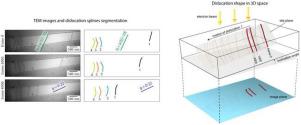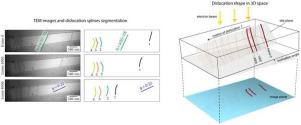实现原位 TEM 实验的定量分析:基于深度学习的高通量方法,专为位错动力学量身定制
IF 8.3
1区 材料科学
Q1 MATERIALS SCIENCE, MULTIDISCIPLINARY
引用次数: 0
摘要
原位 TEM 是目前最常用的显微镜成像方法,用于对位错(即晶体材料中的线状缺陷)进行成像。然而,迄今为止还无法进行定量图像分析,这意味着统计分析也受到很大限制。在这项工作中,我们创建了一个基于深度学习的原位 TEM 应变实验数字孪生模型,还可以进行匹配模拟。作为应用,我们从康托高熵合金实验中提取了移动位错的时空信息,并研究了塑性应变雪崩的普遍性。我们可以直接观察单个位错的 "粘滑运动",并计算相应的雪崩统计量。结果表明,雪崩分布是无标度的,幂律分布的指数与驱动应力无关。所介绍的方法完全通用,有可能将介观尺度 TEM 显微镜变成一种真正定量和可重复的方法。本文章由计算机程序翻译,如有差异,请以英文原文为准。


Enabling quantitative analysis of in situ TEM experiments: A high-throughput, deep learning-based approach tailored to the dynamics of dislocations
In situ TEM is by far the most commonly used microscopy method for imaging dislocations, i.e., line-like defects in crystalline materials. However, quantitative image analysis so far was not possible, implying that also statistical analyses were strongly limited. In this work, we created a deep learning-based digital twin of an in situ TEM straining experiment, additionally allowing to perform matching simulations. As application we extract spatio-temporal information of moving dislocations from experiments carried out on a Cantor high entropy alloy and investigate the universality class of plastic strain avalanches. We can directly observe “stick–slip motion” of single dislocations and compute the corresponding avalanche statistics. The distributions turn out to be scale-free, and the exponent of the power law distribution exhibits independence on the driving stress. The introduced methodology is entirely generic and has the potential to turn meso-scale TEM microscopy into a truly quantitative and reproducible approach.
求助全文
通过发布文献求助,成功后即可免费获取论文全文。
去求助
来源期刊

Acta Materialia
工程技术-材料科学:综合
CiteScore
16.10
自引率
8.50%
发文量
801
审稿时长
53 days
期刊介绍:
Acta Materialia serves as a platform for publishing full-length, original papers and commissioned overviews that contribute to a profound understanding of the correlation between the processing, structure, and properties of inorganic materials. The journal seeks papers with high impact potential or those that significantly propel the field forward. The scope includes the atomic and molecular arrangements, chemical and electronic structures, and microstructure of materials, focusing on their mechanical or functional behavior across all length scales, including nanostructures.
 求助内容:
求助内容: 应助结果提醒方式:
应助结果提醒方式:


